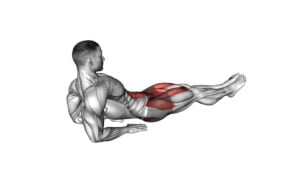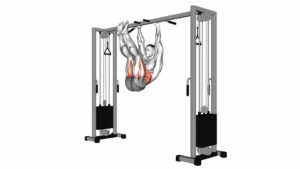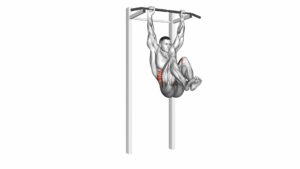Hanging Leg Tuck – Video Exercise Guide & Tips

Are you looking to take your core workout to the next level? Look no further than the Hanging Leg Tuck.
Watch This Exercise Video
This powerful exercise targets your abs, obliques, and hip flexors all at once. With just a pull-up bar and a little determination, you can master this move and see impressive results.
In this video exercise guide, we'll walk you through proper form, modifications, and common mistakes to avoid.
Get ready to challenge yourself and see the results you've been working for.
Key Takeaways
- Hanging Leg Tuck targets abs, obliques, and hip flexors simultaneously
- Hanging Leg Tuck develops strong and stable core
- Hanging Leg Tuck improves posture and prevents injuries
- Hanging Leg Tuck enhances functional strength and athletic performance
Benefits of Hanging Leg Tuck
You can experience increased core strength and stability by incorporating the hanging leg tuck into your workout routine. The hanging leg tuck is a highly effective exercise that targets your abdominal muscles, hip flexors, and lower back. One of the key benefits of this exercise is that it helps to develop a strong and stable core, which is essential for maintaining proper posture and preventing injuries. By regularly performing hanging leg tucks, you can improve your overall functional strength and enhance your athletic performance.
In addition to core strength, the hanging leg tuck also helps to improve your grip strength and upper body stability. As you hang from a bar and lift your legs towards your chest, you're engaging your forearms, biceps, and shoulders to maintain your position. This exercise not only challenges your core muscles but also provides a great workout for your upper body.
Furthermore, the hanging leg tuck can be modified to suit different fitness levels. Beginners can start with knee tucks, where you bend your knees and lift them towards your chest. As you progress, you can advance to straight leg tucks, where you keep your legs straight and lift them as high as possible. These variations allow you to continually challenge yourself and make progress in your fitness journey.
Now that you understand the benefits of the hanging leg tuck, let's move on to the equipment needed to perform this exercise.
Equipment Needed for Hanging Leg Tuck
To perform the hanging leg tuck, you'll need a sturdy pull-up bar or a set of parallel bars. These equipment options provide the necessary support and stability for executing the exercise effectively. If you don't have access to either of these options, there are modifications you can make to still target your core muscles.
One modification for the hanging leg tuck is to use a suspension trainer or gymnastics rings. These tools can be attached to a secure anchor point, such as a door frame or a sturdy tree branch. By gripping the handles or rings and performing the leg tuck motion, you can still engage your core muscles in a similar way.
Another modification is to use a horizontal bar or a Smith machine bar. These options may require additional support, such as resistance bands or a spotter, to help lift your legs. By using these alternatives, you can still perform the hanging leg tuck exercise and work your core muscles effectively.
Now that you know the equipment options and modifications for the hanging leg tuck, it's time to move on to the next section, where we'll discuss the proper form and technique for performing this exercise.
Proper Form and Technique for Hanging Leg Tuck
To perform the hanging leg tuck with proper form and technique, it's crucial to focus on correct body alignment, engaging your core muscles, and maintaining controlled breathing throughout the exercise.
Align your body by keeping your shoulders pulled down and back, chest lifted, and neck relaxed.
Engage your core by actively contracting your abdominal muscles and squeezing your glutes.
Remember to breathe steadily and exhale as you lift your legs, inhaling as you lower them back down.
Correct Body Alignment
When performing the Hanging Leg Tuck, how can you ensure correct body alignment and proper form? Here are some tips to help you maintain the correct body alignment and execute the exercise with proper form:
- Keep your shoulders down and back to engage your upper body muscles effectively.
- Maintain a neutral spine by keeping your core tight and your back straight.
- Avoid swinging or using momentum to lift your legs, as this can compromise your form and reduce the effectiveness of the exercise.
By following these guidelines, you can minimize the risk of common errors such as rounding the back or using too much momentum. Remember to focus on your form and control throughout the movement to engage your core muscles properly.
Now, let's move on to the next section and learn about the importance of engaging core muscles in the Hanging Leg Tuck exercise.
Engaging Core Muscles
Engage your core muscles properly by maintaining a tight and stable midsection during the Hanging Leg Tuck exercise. This is crucial for effectively strengthening your abdominal muscles and maximizing the benefits of this challenging exercise.
To engage your core, focus on contracting your abdominal muscles and pulling your belly button towards your spine. This will create a strong and stable foundation, allowing you to lift your legs and tuck your knees towards your chest with control.
Avoid using momentum or swinging your body, as this can reduce the effectiveness of the exercise and put unnecessary strain on your lower back.
Breathing During Exercise
Maintain a controlled and steady breath pattern while performing the Hanging Leg Tuck exercise to optimize your form and technique. Proper breathing techniques during exercise can enhance your performance and improve oxygen intake.
Here are some tips to help you breathe effectively during the Hanging Leg Tuck:
- Inhale deeply through your nose before you start the movement.
- Exhale as you lift your legs towards your chest, engaging your core muscles.
- Inhale again as you lower your legs back down to the starting position.
By focusing on your breath, you can ensure a steady flow of oxygen to your muscles, providing them with the necessary fuel to perform the exercise correctly.
Modifications and Progressions for Hanging Leg Tuck
Now let's discuss some modifications and progressions for the hanging leg tuck.
If you're a beginner, there are easier progressions you can try to build strength and technique.
On the other hand, if you're an expert looking for a challenge, there are advanced modifications available.
These modifications and progressions can help you tailor the exercise to your current fitness level and continue to make progress.
Easier Progressions for Beginners
Start with the assisted hanging leg tuck to build strength and technique. This modification is perfect for beginners who may not have the core strength yet to perform the full exercise. Here are some beginner tips to help you progress:
- Use a resistance band: Attach a resistance band to the bar and loop it around your knees. This will provide assistance and make the exercise easier.
- Practice knee raises: Instead of tucking your knees up to your chest, focus on lifting them as high as you can while keeping your legs straight.
- Start with bent knees: If straightening your legs is too challenging, begin by tucking your knees up towards your chest with a slight bend.
By starting with these easier modifications and gradually increasing the difficulty, you'll be well on your way to mastering the hanging leg tuck.
Now, let's move on to the advanced modifications for experts.
Advanced Modifications for Experts
To challenge yourself further in the hanging leg tuck, progress to advanced variations and techniques that target your core muscles even more effectively.
One advanced variation is the hanging leg twist, where you bring your knees up to your chest and then rotate them to one side before returning to the starting position. This movement adds an extra challenge to your obliques.
Another advanced technique is the hanging leg raise with ankle weights, which increases the resistance and intensity of the exercise.
By incorporating these advanced modifications into your hanging leg tuck routine, you can continue to challenge your core muscles and make progress towards your fitness goals.
Now, let's explore the benefits of the hanging leg tuck.
Benefits of Hanging Leg Tuck
To maximize the benefits of the hanging leg tuck, incorporate modifications and progressions that challenge your core muscles even further. By doing so, you can't only increase your core strength but also improve your balance.
Here are some modifications and progressions you can try:
- Single leg hanging leg tuck: Instead of using both legs, lift one leg at a time while keeping the other leg extended. This variation increases the demand on your core muscles and helps improve balance.
- Weighted hanging leg tuck: Hold a dumbbell or a weighted plate between your feet while performing the exercise. Adding extra weight increases the resistance and intensifies the core workout.
- L-sit hanging leg tuck: Instead of bending your legs, keep them straight and raise them until they're parallel to the ground, forming an L-shape with your body. This progression further challenges your core strength and balance.
Incorporating these modifications and progressions into your hanging leg tuck routine will enhance your core strength and improve your balance, taking your workout to the next level.
Common Mistakes to Avoid During Hanging Leg Tuck
One common mistake to avoid during the Hanging Leg Tuck is rushing through the exercise without maintaining proper form. Many people tend to get caught up in the speed of the movement and sacrifice their technique. However, it's crucial to prioritize proper form to maximize the effectiveness of the exercise and prevent injuries.
One common mistake isn't engaging the core muscles fully. To perform the Hanging Leg Tuck correctly, you need to engage your abdominal muscles and squeeze them as you lift your legs towards your chest. This ensures that you're targeting the right muscles and getting the most out of the exercise.
Another mistake is swinging your body or using momentum to lift your legs. This not only takes away the emphasis from the core muscles but also increases the risk of straining your lower back. To avoid this, focus on controlled and slow movements, lifting your legs using the strength of your core muscles.
Lastly, avoid using your arms excessively to lift your legs. The primary focus should be on engaging the core muscles. Using your arms too much can lead to uneven muscle development and may hinder your progress.
Tips to Maximize Your Hanging Leg Tuck Results
To maximize your results with the Hanging Leg Tuck, focus on maintaining proper form and engaging your core muscles throughout the exercise. Here are some tips to help you improve your core strength and maximize your results:
- Keep your core tight: Throughout the exercise, make sure to engage your abdominal muscles by pulling your belly button towards your spine. This will help you maintain stability and control.
- Control the movement: Avoid swinging or using momentum to complete the exercise. Instead, focus on controlled movements, lifting your legs up towards your chest and lowering them back down slowly.
- Gradually increase difficulty: As you become stronger, you can challenge yourself by adding ankle weights or performing the exercise on a decline bench. This will further engage your core muscles and maximize your results.
Frequently Asked Questions
How Many Calories Can I Burn by Doing Hanging Leg Tuck?
By doing hanging leg tucks, you can burn a significant amount of calories while working your core muscles. This exercise requires proper form to maximize calorie burn and effectiveness.
Focus on engaging your abs and using your core strength to lift your legs towards your chest while hanging from a bar. Remember to breathe properly and maintain control throughout the movement.
Incorporating hanging leg tucks into your workout routine can help you achieve your calorie burning goals.
Can I Perform Hanging Leg Tuck if I Have Lower Back Pain?
Performing the hanging leg tuck can worsen lower back pain if you have any existing issues. It puts strain on your lower back and may exacerbate the pain.
However, there are modifications you can make to still engage your core without hurting your back. You can try alternative exercises like knee tucks or plank variations that put less stress on your lower back.
It's important to listen to your body and consult with a professional if you have concerns.
How Long Should I Rest Between Sets of Hanging Leg Tuck?
To ensure maximum effectiveness and prevent injury, it's important to rest between sets of hanging leg tucks. Resting periods will vary depending on your fitness level and goals, but a common recommendation is to rest for about 30-60 seconds between sets.
This allows your muscles to recover and maintain proper form throughout the exercise. Remember to listen to your body and adjust the resting period as needed.
Can I Do Hanging Leg Tuck Every Day?
Yes, you can do the hanging leg tuck every day if you want to. Doing this exercise regularly can help strengthen your abdominal muscles and improve your core stability.
However, it's important to listen to your body and give yourself enough rest between sessions to avoid overtraining.
If you want to increase the intensity, you can also try doing the hanging leg tuck with weights. This can provide additional resistance and further challenge your muscles.
What Are Some Alternative Exercises to Hanging Leg Tuck That Target the Same Muscle Groups?
If you're looking for alternative exercises that target the same muscle groups as the hanging leg tuck, there are a few options you can try.
Some exercises that work similar muscles include knee raises, hanging knee tucks, and mountain climbers.
These exercises engage your core, hip flexors, and lower abs, just like the hanging leg tuck.
Incorporating these alternative exercises into your routine can help you vary your workouts and continue targeting those muscle groups effectively.
Conclusion
To maximize your results with the hanging leg tuck, focus on maintaining proper form and technique. Use the equipment needed, such as a pull-up bar, and avoid common mistakes like swinging or using momentum.
Progressions and modifications can help you gradually increase the difficulty of the exercise.
With consistency and dedication, the hanging leg tuck can be an effective way to strengthen your core and improve overall fitness.

Author
Years ago, the spark of my life’s passion ignited in my mind the moment I stepped into the local gym for the first time. The inaugural bead of perspiration, the initial endeavor, the very first surge of endorphins, and a sense of pride that washed over me post-workout marked the beginning of my deep-seated interest in strength sports, fitness, and sports nutrition. This very curiosity blossomed rapidly into a profound fascination, propelling me to earn a Master’s degree in Physical Education from the Academy of Physical Education in Krakow, followed by a Sports Manager diploma from the Jagiellonian University. My journey of growth led me to gain more specialized qualifications, such as being a certified personal trainer with a focus on sports dietetics, a lifeguard, and an instructor for wellness and corrective gymnastics. Theoretical knowledge paired seamlessly with practical experience, reinforcing my belief that the transformation of individuals under my guidance was also a reflection of my personal growth. This belief holds true even today. Each day, I strive to push the boundaries and explore new realms. These realms gently elevate me to greater heights. The unique combination of passion for my field and the continuous quest for growth fuels my drive to break new ground.







